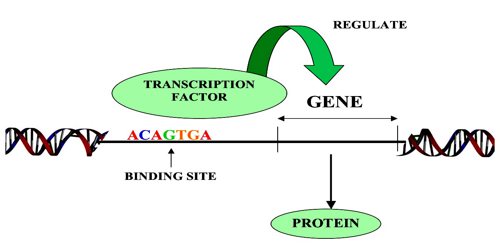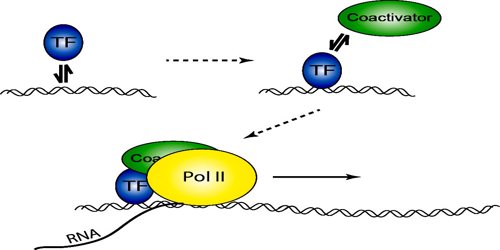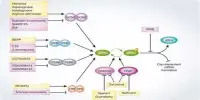Transcription Factor
Definition
Transcription factors (TFs) are proteins that regulate the transcription of genes—that is, their copying into RNA, on the way to making a protein. They are usually proteins, although they can also consist of short, non-coding RNA. TFs are also usually found working in groups or complexes, forming multiple interactions that allow for varying degrees of control over rates of transcription.

Their function is to regulate – turn on and off – genes in order to make sure that they are expressed in the right cell at the right time and in the right amount throughout the life of the cell and the organism. Groups of TF’s function in a coordinated fashion to direct cell division, cell growth, and cell death throughout life; cell migration and organization (body plan) during embryonic development; and intermittently in response to signals from outside the cell, such as a hormone. There are up to 2600 TFs in the human genome.
Eukaryotes often have a promoter region upstream from the gene or enhancer regions up or downstream from the gene, with certain specific motifs that are recognized by the various types of TF. The TFs bind, attract other TFs and create a complex that eventually facilitates binding by RNA polymerase, thus beginning the process of transcription.
Mechanism and Functions of Transcription Factor
Transcription factors are vital for the normal development of an organism, as well as for routine cellular functions and response to disease. Transcription factors are a very diverse family of proteins and generally function in multi-subunit protein complexes. They may bind directly to special “promoter” regions of DNA, which lie upstream of the coding region in a gene, or directly to the RNA polymerase molecule. Transcription factors can activate or repress the transcription of a gene, which is generally a key determinant in whether the gene functions at a given time.

Transcription factors use a variety of mechanisms for the regulation of gene expression. These mechanisms include:
- Stabilize or block the binding of RNA polymerase to DNA
- Catalyze the acetylation or deacetylation of histone proteins. The transcription factor can either do this directly or recruit other proteins with this catalytic activity.
- Recruit coactivator or corepressor proteins to the transcription factor DNA complex
Most transcription factors are called general transcription factors. These are the transcription factors that control the beginning of transcription and are sometimes also referred to as basal transcription factors. General transcription factors are very common and are actually required for all RNA transcription. In fact, they are so important to this process that many researchers actually consider them to be a necessary component of life. General transcription factors generally bind to the DNA at promoters, short sections of DNA responsible for initiating the transcription of a particular gene.
Transcription factors are a common way in which cells respond to extracellular information, such as environmental stimuli and signals from other cells. Transcription factors can have important roles in cancer, if they influence the activity of genes involved in the cell cycle. In addition, transcription factors can be the products of oncogenes or tumour suppressor genes.
Transcription factors function in the nucleus, where genes are found, and nuclear transport of transcription factors can influence their activity. Another important general mechanism controlling the activity of transcription factors is posttranslational modification such as phosphorylation. Finally, in addition to controlling the genes and transcription of other transcription factors, these protein complexes can also control the genes responsible for their own transcription, leading to complex feedback control mechanisms.

Gene Expression and Life Expectancy
Manipulating Transcription factors (TFs) to reverse the cell differentiation process is the basis of methods for deriving stem cells from adult tissues. The ability to control gene expression, along with knowledge obtained from studying the human genome and genomics in other organisms, has led to the theory that we can prolong our lives if we just control the genes that regulate the aging process in our cells.
Reference:
















